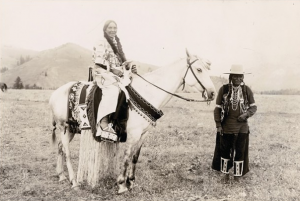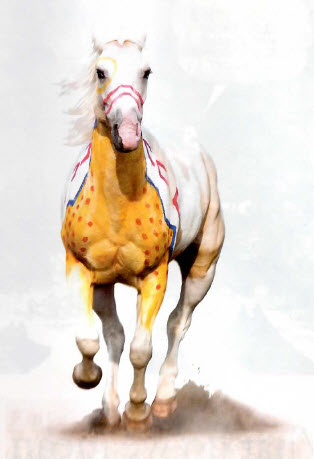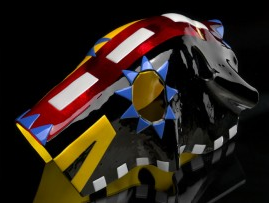Jordan Wright
November 26, 2011
Special to Indian Country Today Media Network
Out of the earth
I sing for them,
A Horse nation
I sing for them,
out of the earth
I sing for them,
the animals
I sing for them.
Sung by Lone Man of the Teton Lakota – From the book “A Song for the Horse Nation”, edited by Emil Her Many Horses (Oglaa Lakota) and George P. Horse Capture (A’aninin).
As much poem and prayer as personal tribute, this song shows the respect and reverence American Indians have accorded the horse. For the past three centuries this noble beast has been indispensable to their existence during times of war and peace, altering the landscape of daily life for its caretakers.
The bond between the horse and Native peoples is the focus of the National Museum of the American Indian’s recently opened exhibition, “A Song for the Horse Nation” in Washington, DC. Originally shown on a smaller scale in New York City in 2009, the show has grown to include a sixteen-foot tall Lakota tipi adorned with horse and warrior hand-painted pictographs and fifty additional objects, along with life-size horse and dog statues displaying a Tsisistas/So’taeo’o (Cheyenne) travois ca. 1880, a type of sled made of wood, pigment and hide, commonly used for transporting goods and people.
Rifles belonging to Geronimo (Chiricahua Apache), Chief Joseph (Nez Perce) and Chief Rain-in-the-Face (Hunkpapa Lakota) are also highlights of this spectacular exhibition.
Winter Count on cloth by Long Soldier (Hunkpapa Lakota), ca. 1902. Fort Yates, North Dakota. Muslin cloth. With the advent of the domesticated horse came an unparalleled defense for the Plains warriors, who could ride great distances as well as provide an expeditious escape from the firepower of advancing troops. It served as a vehicle for transport of possessions and people and allowed tribes to roam more freely during hunting season affording them more leisure time to pursue art, spirituality and philosophy. Primitive pictographs of horses painted on muslin reflect daily life, showing the versatility of the horse for hunting and battle as well as horse raids and courtship.
Horses were bred not only for daily use – the hunting of bison was made considerably easier while mounted on horseback – but also for trade, proving to be an excellent commodity in exchange for food, eagle feathers and tobacco. We learn from the exhibit that in the 1800’s a single horse could be traded for 10 guns, 5 tipi poles or several pack animals.
Though the exhibition features objects predominantly from the 18th and 19th Centuries, two of the oldest objects on display are a Spanish Conquistador helmet from the late 1500’s-early 1600’s, on loan from the Autry National Center, and a Seneca comb from around 1600 made of antler with a carved figure of a horse from the George Gustav Heye collection.
Drawing from the museum’s extensive collection of horse trappings as well as artifacts, artwork and personal accounts, are a Menominee wood saddle carved in the shape of a horse ca. 1875; a Northern Cheyenne quilled horse mask; No Two Horns (Hankapapa Lakota) dance stick; a Lakota hide coat embroidered with horse motifs; and historic photographs from the museum’s archives. Along with elaborately beaded regalia and tribal objects, are also stunning works from contemporary artists.
Glass horse mask, 2008, by Marcus Amerman (Choctaw, b. 1959), New Mexico. Multicolored glass.
Marcus Amerman’s (Choctaw) multicolored glass horse mask is a particularly dramatic piece that echoes the celebratory beaded masks still used in rodeos and mounted parades. The sculpture shares space with “Crow War Pony”, a spectacular photograph by Brady Willette of a war pony, painted in tribal symbols, by artist, rodeo bronco buster and horse whisperer, Kennard Real Bird (Crow) whose family’s ranch lies alongside The Little Big Horn River in Montana, and who is known for his annual reenactment of the Battle of Little Big Horn that draws visitors from around the world. The painted pony is named “Cool Whip”. Trained by Real Bird, the palomino was eventually sold to a family in Minnesota where he has garnered his own notoriety.
It is fitting that Emil Her Many Horses is the curator of this equine exhibit. A member of the Oglala Lakota nation of South Dakota, Her Many Horses is a specialist in Central Plains cultures. His paternal great-grandmother was called Many Horses Woman, meaning she owned many horses, a symbol of wealth and generosity.
“All horses used by Native Americans throughout North America and Canada originally descended from 25 Andalusian horses brought over by Christopher Columbus on his second voyage in 1493 to Hispaniola [now the Dominican Republic] in the West Indies, eventually making their way through Mexico and Florida and into North America where Plains peoples adopted the horse,” he explains.
“A display map shows California horses going up North, and then the French and Dutch to the East Coast later. With the Pueblo Revolt horses came into Native hands, and then it would be the Navaho, the Arapaho, the Pueblos and the Commanche who have horses. Then they are traded up North, but the Commanche are known to also trade them up to the Shoshone.
I think what we tried to show was really the impact of horses and hunting, because with horses you were able to secure more game such as buffalo and if you could secure more game you had more resources. Since if you didn’t have horses you were hunting buffalo on foot. So the thing that happens is that tipis become bigger because you have more time to make a tipi.
In warfare, other communities who may have been an ally in the past, if they had this resource and you wanted it, it would cause conflict with people that were once allies. But horses also helped in preventing the onslaught of the cavalry and settlers. It kept them at bay.

Possibly Chief Eagle of the Salish (at right), with an unidentified woman on horseback, ca. 1905, St. Ignatius, Montana, on the Flathead Reservation.
Horses also would have an impact on how you traveled. It was either the woman or the dog that would have to carry the material while the men were guarding as they moved camp, because at any time they could be attacked by an enemy scouting party. So it was either the dog or the woman that would carry the material. But when the horses came it made for a swifter getaway. You could be out of there much quicker than to try to wrangle a dog.”
When asked what he hoped visitors would take away from this exhibition, he offers, “It really is the close association with horses that we still have today. For some the horse is very vibrant, still a part of their communities. For some of us it will always be a part of us through our stories, our culture, and our artwork even though we no longer own any horses. But they’re still rich in our culture, our memory and our knowledge.
“A Song for the Horse Nation” runs through January 7, 2013 at the National Museum for the American Indian in Washington, DC. For more information visit www.AmericanIndian.si.edu/exhibitions/horsenation.


Leave a Reply